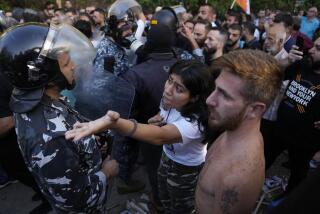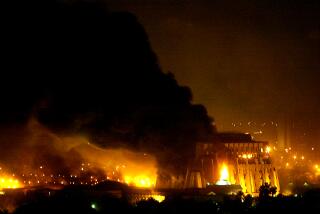A Shattered Afghanistan Finds Nothing to Celebrate
We always knew the Soviets would leave, my Afghan friends and I, but we never thought it would be like this, with bloody anarchy stalking 2 million civilians in the winter-bound capital of Kabul. Somehow our naive idealism envisioned a joyous triumph, a liberation, a clear victory. We joked about being “on the first jeep into the liberated city of Kabul,” a homecoming to a city I left days before the Soviet invasion. Noor Jehan, a fiery-tongued, widowed refugee, expressed the passion of millions when she cried, “If God wills, we will run toward Afghanistan, we will run barefoot as fast as we can, as soon as we hear that our homeland is free.”
In the darkest years of the war, few foreign analysts believed the Soviets would ever leave. There were grim predictions of Afghanistan becoming another Soviet republic, or the country being split. The Soviets had never retreated once they invaded, pundits pointed out, so we might as well accept Afghanistan as lost and control the damage.
But there was a factor that simply would not fit into statistical calculations and political projections: the faith of the Afghan people. They truly believed they could repulse the Soviets, as the people of Afghanistan had sooner or later repulsed every invader in their history. Those who knew the Afghans well knew that they really would fight “till the last breath, till the last drop of blood,” an oft-quoted phrase. No one ever “died” in the war; he or she “was martyred,” and thus reserved a special place in Paradise. Yet Afghan faith was rarely fanatical. Most fighters wanted to live to fight another day, but bravely accepted the possibility of martyrdom.
Certainly the advent of Mikhail S. Gorbachev and glasnost created a favorable climate for Soviet withdrawal, as the venture could be blamed on his predecessors. But it was the proud and lonely faith of the Afghan people that enabled them to go on fighting for nine years, like someone hoping to stay alive long enough to find a miracle drug.
As the Soviets left, there were no jeeps rolling triumphantly into the besieged city of Kabul, no flowers for the moujahedeen freedom fighters, little enough celebration. Many mourned, for the Soviets had bombed civilians near the strategic Salang Tunnel just before the pullout began. The moujahedeen, not party to the Geneva Accords, were still fighting, tightening the noose around an ill-supplied city of frightened, cold, hungry civilians, many their supporters.
Nor will there be a mass return of the 5 million refugees in Pakistan and Iran. Noor Jehan will not lead her family back to her broken village, barefoot on the cold stones, for the Soviets have left 10 million to 30 million land mines as a legacy to the people of Afghanistan.
Still, the Soviets really are leaving. Western news coverage in recent months has been less of heroic Afghan resistance fighters and more of anxious young Soviet boys in Kabul, waiting for their numbers to come up in either the death lottery or the home lottery. The parallels with Vietnam are chilling.
A messy war is now turning into a messy civil war. Communists and collaborators scramble for available visas, as Najibullah’s government stumbles without its Soviet prop and Afghan soldiers, mostly reluctant conscripts, are caught in the middle. While Najibullah continues to insist that the People’s Democratic Party is “a major power” in Afghanistan, moujahedeen representatives are equally insistent that there is no place for communists in a postwar government.
The moujahedeen and their supporters are unlikely to be forgiving toward those whom they hold responsible for the deaths of a million Afghans. Unfortunately, it may be hard to tell who was really a collaborator and who a “good Muslim.” Many high party officials will have the cash and connections to get out, while ordinary party members and young conscripts will be left to face a violent and unforgiving populace.
A period of anarchy may follow the fall of Najibullah’s government, as there is no nationally accepted leader. The Pakistan-based moujahedeen leadership remains fractured, despite plans to elect a transitional government. A few battle-proved commanders are much admired, but none universally. Many educated Afghans, particularly women, fear that the extreme fundamentalist faction, supported by the United States all these years, could establish a government based on an intolerant brand of Islam. Without U.S. guns and money, however, they are not likely to maintain the loyalty of the majority of non-fanatical Afghans for long. Factions may battle one another, as they have with varying degrees of hostility over the past nine years. The one hope is that, as the late poet Ustad Khalilullah Khalili said to me a few years ago, “People will soon tire of civil war. They have seen enough fighting and death.”
Another uncertainty is the fate of 20,000 children who were taken forcibly from their parents for “education” in the Soviet Union. Will they be returned to their families, or are they the seeds of future communist cadres? And what of several hundred Soviet prisoners ofwar? Will the moujahedeen release them, and if so, will these soldiers dare return home?
Strangely, in all these years of covering the war and the refugees, no one I knew well had been killed. On my last visit to Pakistan, in December, I apprehensively asked about the moujahedeen who had escorted me on my two trips into the war zone, patient with my plodding pace, understanding of my fears. I sighed with relief when told they were all fine and still fighting. Then one night someone came and said, “I have bad news about Azim. He was martyred a few months ago.”
Azim Zarbakhsh, our wonderful flute-playing friend, our ecstatic Sufi with the long hair and the Rasputin beard. He would spout Pashtu and Farsi poetry on the spot, then launch into Afghan folk songs on his homemade wooden flute. He played in the houses of the wealthy and the rooms of the poor, preferring kebabs and tea to the fancy buffet dinners where he was embarrassed because he didn’t know how to use a knife and fork. He was a wandering minstrel, a free spirit, a freedom fighter who died in the last months of the war.
For the Afghans, this has been a righteous war, one they had no choice but to fight. Afghanistan has not known such destruction since the time of Genghis Khan. Observers estimate that 50% of the villages are in ruins and that roads, wells and irrigation systems are destroyed or fallen into disrepair. Now that the war is “over,” now that the Afghans are no longer fighting the Soviets, but among themselves, the United States must support this nation of survivors in its efforts to rebuild. Ironically, the Soviet Union has pledged the largest amount so far toward reconstruction.
More to Read
Sign up for Essential California
The most important California stories and recommendations in your inbox every morning.
You may occasionally receive promotional content from the Los Angeles Times.










